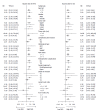Nomogram based on tumor-associated neutrophil-to-lymphocyte ratio to predict survival of patients with gastric neuroendocrine neoplasms
- PMID: 29307997
- PMCID: PMC5743508
- DOI: 10.3748/wjg.v23.i47.8376
Nomogram based on tumor-associated neutrophil-to-lymphocyte ratio to predict survival of patients with gastric neuroendocrine neoplasms
Abstract
Aim: To assess the predictive value of the tumor-associated neutrophil-to-lymphocyte ratio in terms of the clinical outcomes of patients with gastric neuroendocrine neoplasms after radical surgery.
Methods: Data were retrospectively collected from 142 patients who were diagnosed with gastric neuroendocrine neoplasms and who underwent radical gastrectomy at our department from March 2006 to March 2015. These data were retrospectively analyzed, and a receiver operating characteristic curve analysis was used to identify the optimal value of the tumor-associated neutrophil-to-lymphocyte ratio. Univariate and multivariate survival analyses were used to identify prognostic factors. A nomogram was then applied to predict clinical outcomes after surgery.
Results: The tumor-associated neutrophil-to-lymphocyte ratio was significantly associated with tumor recurrence, especially with liver metastasis and lymph node metastasis (P < 0.05 for both), but not with clinical characteristics (P > 0.05 for all). A multivariate Cox regression analysis identified the tumor-associated neutrophil-to-lymphocyte ratio as an independent prognostic factor for recurrence-free survival and overall survival (P < 0.05 for both). The concordance index of the nomograms, which included the tumor-associated neutrophil-to-lymphocyte ratio, Ki-67 index, and lymph node ratio, was 0.788 (0.759) for recurrence-free survival (overall survival) and was higher than the concordance index of the traditional TNM staging system [0.672 (0.663)].
Conclusion: The tumor-associated neutrophil-to-lymphocyte ratio is an independent prognostic factor in patients with gastric neuroendocrine neoplasms. Nomograms that include the tumor-associated neutrophil-to-lymphocyte ratio, Ki-67 index, and lymph node ratio have a superior ability to predict clinical outcomes of postoperative patients.
Keywords: Gastric neuroendocrine neoplasms; Prognosis; Tumor recurrence; Tumor-associated neutrophil-to-lymphocyte ratio.
Conflict of interest statement
Conflict-of-interest statement: The authors declare that there are no conflicts of interest associated with the publication of this manuscript.
Figures




Similar articles
-
A novel predictive model based on preoperative blood neutrophil-to-lymphocyte ratio for survival prognosis in patients with gastric neuroendocrine neoplasms.Oncotarget. 2016 Jul 5;7(27):42045-42058. doi: 10.18632/oncotarget.9805. Oncotarget. 2016. PMID: 27275541 Free PMC article.
-
Predictive value of preoperative peripheral blood neutrophil/lymphocyte ratio for lymph node metastasis in patients of resectable pancreatic neuroendocrine tumors: a nomogram-based study.World J Surg Oncol. 2017 May 30;15(1):108. doi: 10.1186/s12957-017-1169-5. World J Surg Oncol. 2017. PMID: 28558772 Free PMC article.
-
Novel immunological and nutritional-based prognostic index for gastric cancer.World J Gastroenterol. 2015 May 21;21(19):5961-71. doi: 10.3748/wjg.v21.i19.5961. World J Gastroenterol. 2015. PMID: 26019461 Free PMC article.
-
Prognostic value of neutrophil-lymphocyte ratio in gastroenteropancreatic neuroendocrine neoplasm: a systematic review and meta-analysis.PeerJ. 2025 Apr 7;13:e19186. doi: 10.7717/peerj.19186. eCollection 2025. PeerJ. 2025. PMID: 40212371 Free PMC article.
-
Gastric neuroendocrine neoplasms type 1: A systematic review and meta-analysis.World J Gastroenterol. 2019 Sep 21;25(35):5376-5387. doi: 10.3748/wjg.v25.i35.5376. World J Gastroenterol. 2019. PMID: 31558880 Free PMC article.
Cited by
-
Prognostic nomogram based on the metastatic lymph node ratio for gastric neuroendocrine tumour: SEER database analysis.ESMO Open. 2020 Apr;5(2):e000632. doi: 10.1136/esmoopen-2019-000632. ESMO Open. 2020. PMID: 32253246 Free PMC article.
-
Is the neutrophil-to-lymphocyte ratio a useful prognostic indicator in melanoma patients?Melanoma Manag. 2020 Aug 25;7(3):MMT47. doi: 10.2217/mmt-2020-0006. Melanoma Manag. 2020. PMID: 32922729 Free PMC article. Review.
-
A CT-based diagnostic nomogram and survival analysis for differentiating grade 3 pancreatic neuroendocrine tumors from pancreatic ductal adenocarcinomas.Front Oncol. 2024 Aug 29;14:1443213. doi: 10.3389/fonc.2024.1443213. eCollection 2024. Front Oncol. 2024. PMID: 39267841 Free PMC article.
-
Serum Inflammation-based Scores in Endocrine Tumors.J Clin Endocrinol Metab. 2021 Sep 27;106(10):e3796-e3819. doi: 10.1210/clinem/dgab238. J Clin Endocrinol Metab. 2021. PMID: 33837783 Free PMC article. Review.
-
Combining lymph node ratio to develop prognostic models for postoperative gastric neuroendocrine neoplasm patients.World J Gastrointest Oncol. 2024 Aug 15;16(8):3507-3520. doi: 10.4251/wjgo.v16.i8.3507. World J Gastrointest Oncol. 2024. PMID: 39171165 Free PMC article.
References
-
- Burkitt MD, Pritchard DM. Review article: Pathogenesis and management of gastric carcinoid tumours. Aliment Pharmacol Ther. 2006;24:1305–1320. - PubMed
-
- Niederle MB, Hackl M, Kaserer K, Niederle B. Gastroenteropancreatic neuroendocrine tumours: the current incidence and staging based on the WHO and European Neuroendocrine Tumour Society classification: an analysis based on prospectively collected parameters. Endocr Relat Cancer. 2010;17:909–918. - PubMed
-
- Klöppel G, Perren A, Heitz PU. The gastroenteropancreatic neuroendocrine cell system and its tumors: the WHO classification. Ann N Y Acad Sci. 2004;1014:13–27. - PubMed
-
- Bosman FT, Carneiro F, Theise ND. Nomenclature and classification of neuroendocrine neoplasms of digestive system. WHO classification of tumours of the digestive system. 4th ed. Lyon: IARC Press; 2010.
Publication types
MeSH terms
LinkOut - more resources
Full Text Sources
Other Literature Sources
Medical

